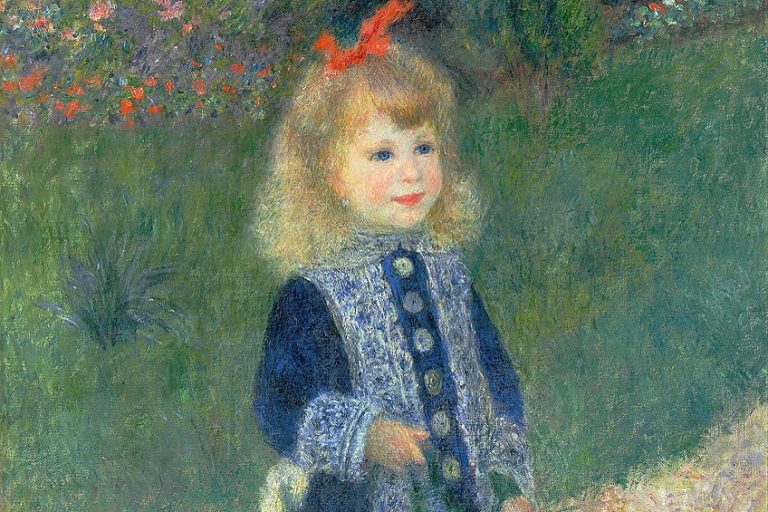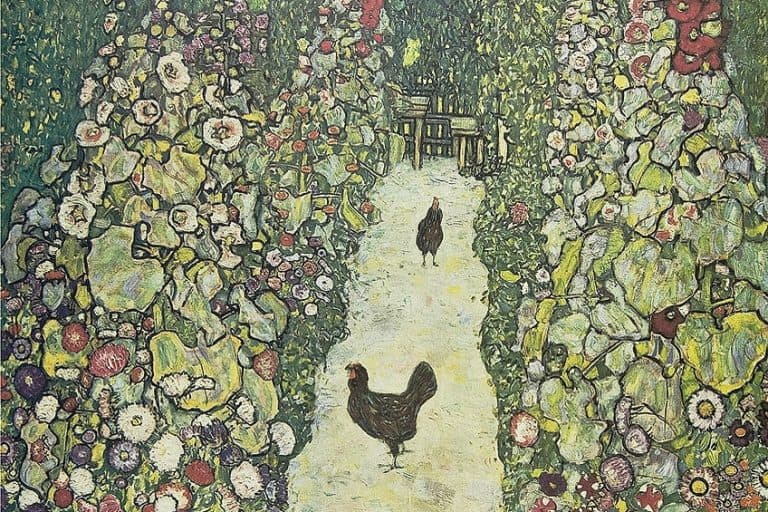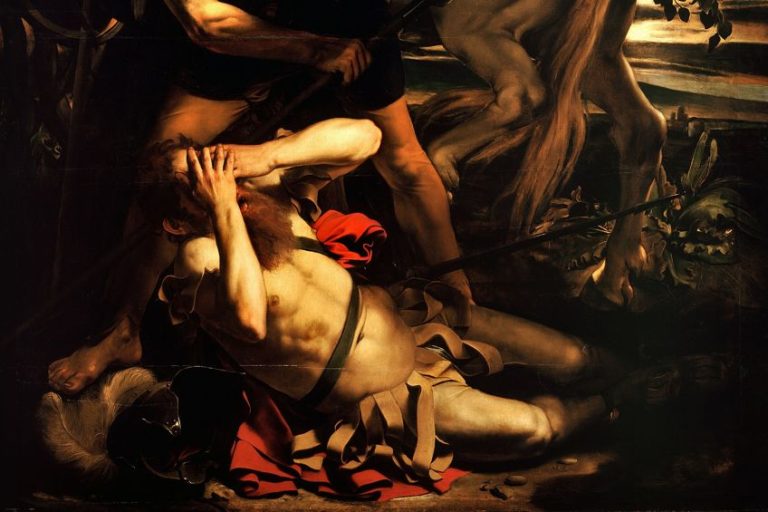“Truth Coming Out of Her Well” by Jean-Léon Gérôme – Analysis
When thinking about the idea of truth personified, you probably don’t imagine that it is a woman, let alone a woman climbing out of a well. To tell you the truth, this is the subject of Jean-Léon Gérôme’s painting titled Truth Coming Out of Her Well (1896), which this article will discuss further.
Artist Abstract: Who Was Jean-Léon Gérôme?
Jean-Léon Gérôme was born in Vesoul in France on May 11, 1824, and died in Paris on January 10, 1904. He painted within the Neoclassical or Academic and Oriental art styles. He started art from a young age, learning drawing from teachers like Claude Basil Cariage and Paul Delaroche. He also studied at the École des Beaux-Arts and traveled to various countries in the world like Rome, Egypt, Jerusalem, Turkey, Greece, and others. He was known for his Oriental paintings and for being against Impressionism. Some of his artworks include Diogenes (1860), The Cock Fight (1846), and The Snake Charmer (c. 1879).
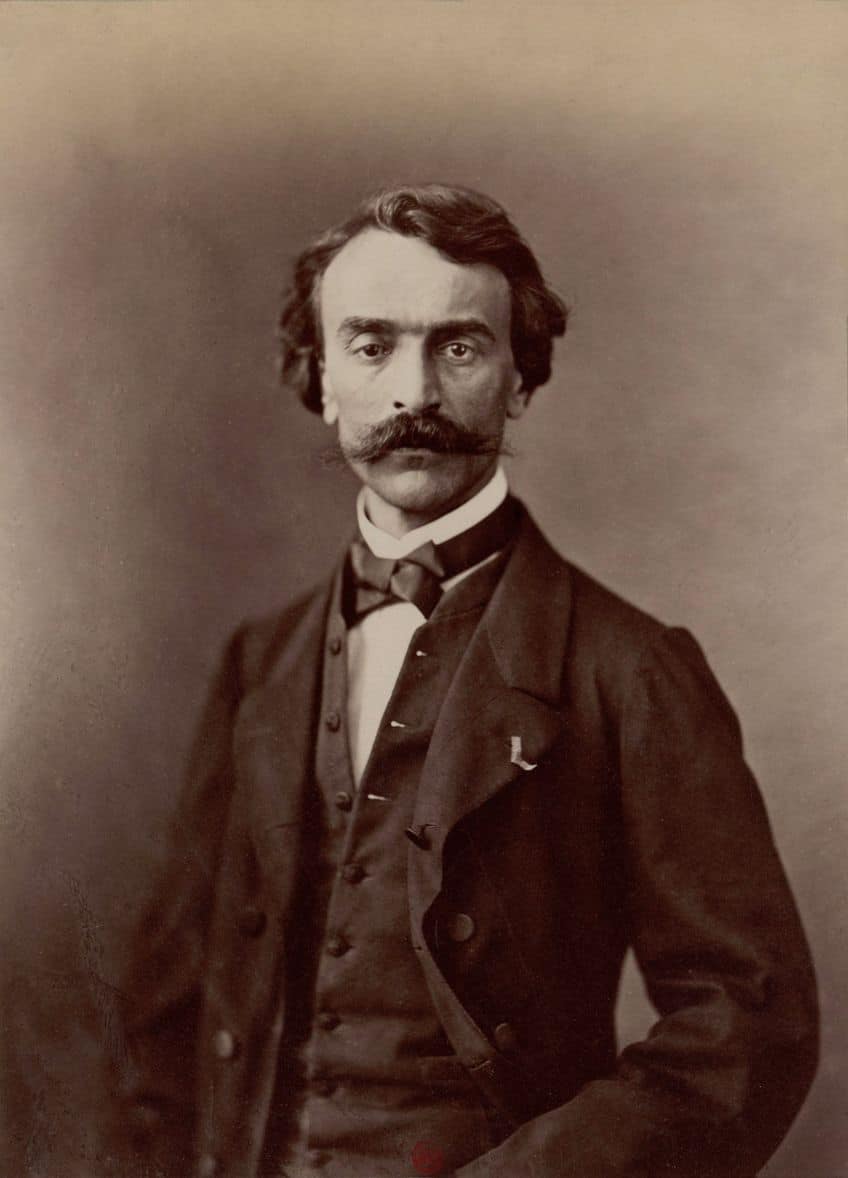
Truth Coming Out of Her Well (1896) by Jean-Léon Gérôme in Context
Below you will read more about Truth Coming Out of Her Well by Jean-Léon Gérôme. The article will start with a contextual analysis around when and why the artist painted it, which will be followed by a formal analysis of the elements of art.
| Artist | Jean-Léon Gérôme |
| Date Painted | 1896 |
| Medium | Oil on canvas |
| Genre | Allegorical painting |
| Period/Movement | Academicism |
| Dimensions (cm) | 91 x 72 |
| Series/Versions | Part of a series of four paintings with the similar theme |
| Where Is It Housed? | Musée Anne de Beaujeu, Moulins, France |
| What It Is Worth | Uncertain |
Contextual Analysis: A Brief Socio-Historical Overview
Jean-Léon Gérôme was a Neoclassical and Orientalist painter, active during the 1800s, and painted Truth Coming Out of Her Well in 1896, which was during the later years of his life. The nude woman in Truth Coming Out of Her Well by Jean-Léon Gérôme is the personification of Truth. Many sources have pointed its origins to the statement, or idiom, by the Greek philosopher Democritus, who said that not much is known of truth, and it lies in a well.
The visual depiction of Truth exiting the well can point to the truth coming out and the apparent sunlight on the wall behind Truth could also symbolize the light shining on the darkness.
There is wide scholarly debate about why the artist painted it and what it could symbolize. For example, some debates suggest that it was a response to the Dreyfus Affair, which was a scandal in France from 1894 to 1906. Other scholars have pointed to the Truth Coming Out of Her Well painting as being a reaction against the emerging new art style of Impressionism and how different it was compared to Jean-Léon Gérôme’s more academic art style.
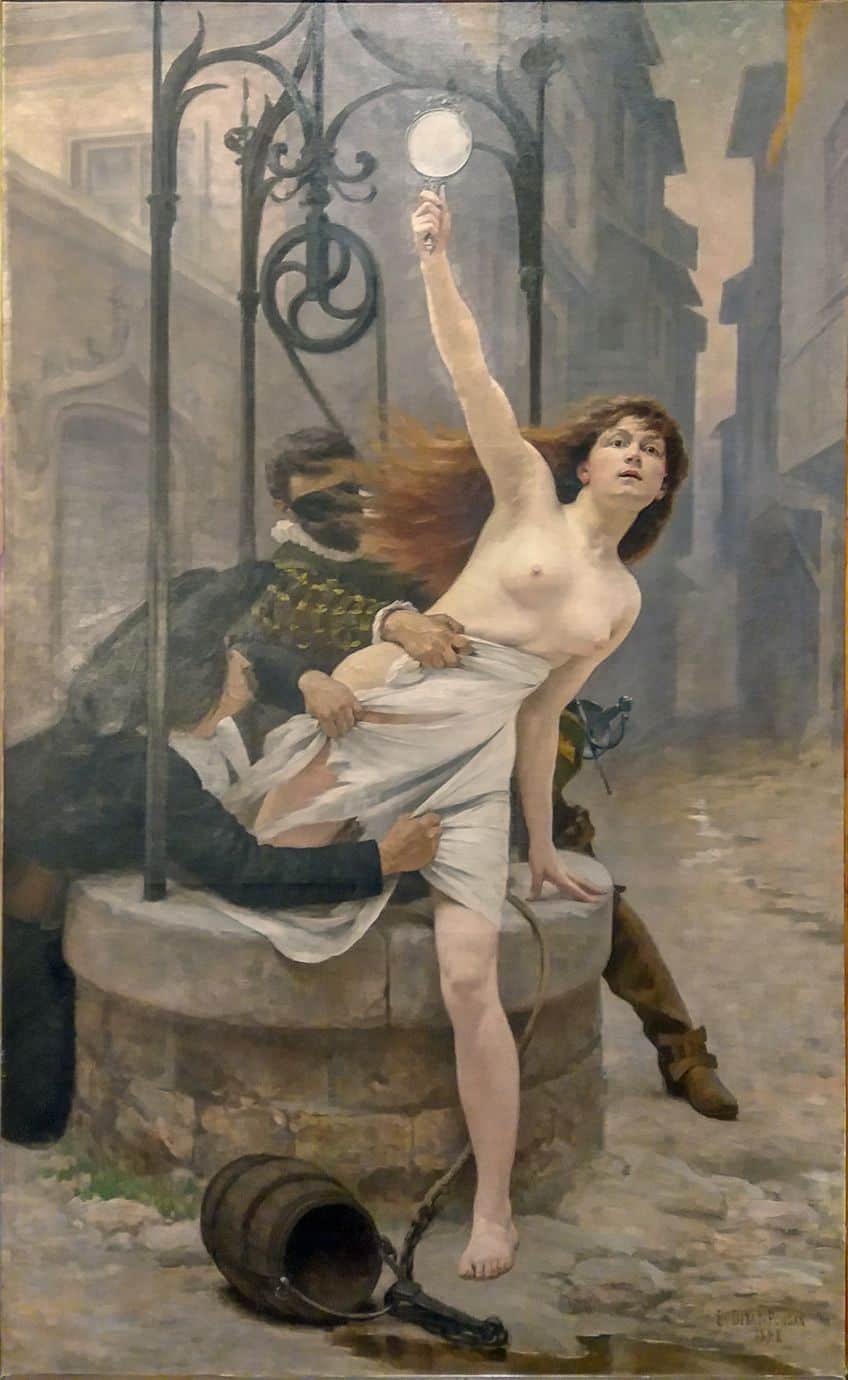
The artist has also been quoted from the preface of Le Nu Esthétique (1902) by Émile Bayard that photography has allowed artists to open their eyes and see what has not been seen and that “thanks to photography” Truth has been able to come out of the well. This has often been attributed to why Gérôme may have created the painting.
More Than One Truth
Jean-Léon Gérôme painted more than one painting about “Truth” inside or coming out of the well. There were reportedly three others, namely Mendacibus et histrionibus occisa in puteo jacet alma Veritas (The Nurturer Truth Lies In a Well, Having Been Killed by Liars and Actors) (1895), Truth is at the Bottom of the Well (1895), and Truth at the Bottom of a Well (1895).
Formal Analysis: A Brief Compositional Overview
The formal analysis below will look at the Truth Coming Out of Her Well painting and what the subject matter consists of with mention of the arrangement of the art elements.
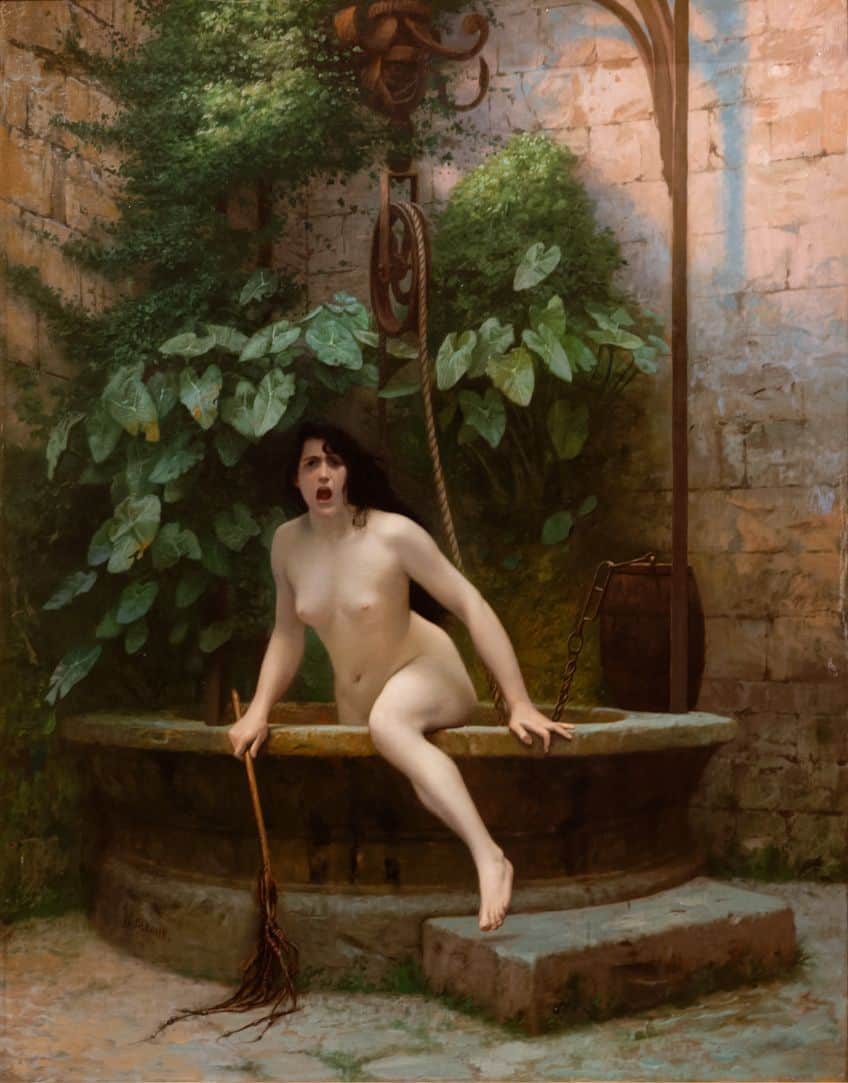
Subject Matter: Visual Description
In Truth Coming Out of Her Well by Jean-Léon Gérôme a nude woman is seen climbing out of a large well. Her left leg is positioned over the well’s wall, her toes are almost touching a step attached to the well’s base, ready to stand up on it. Her right leg is on the inside of the well, not visible to us, the viewers. Her left hand is steadied on the well’s wall and her right hand is holding a whip, which is hanging to the floor. She is facing us, the viewers, and her mouth is open as if she is shouting at or calling out to someone, or us. Her facial expression appears angry, but this can also be interpreted as a spirited or passionate outcry.
The surrounding environment appears to be a bricked courtyard of sorts with a stone brick floor.
The well is stationed in the corner where the two walls meet. The well’s pulley is hanging above its opening attached to what appears to be an iron hook and tall rod. The latter is to the woman’s left (our right) including what appears to be the bucket positioned on the flat rim of the well.
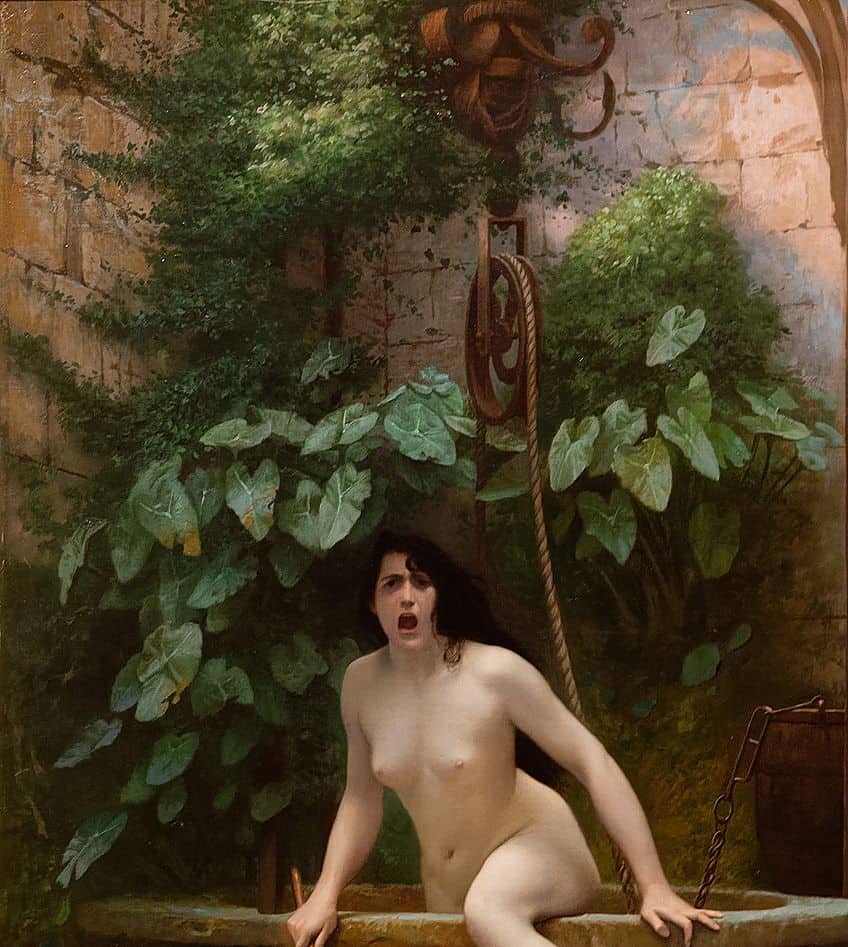
Behind the well are various green plants growing up and down the wall area as well as mossy parts between the bricked floor, between where the floor and walls meet, and the well’s step. The area appears to be shadowy and moist, however, there appears to be some light sunlight creeping against the upper portion of the wall behind the woman.
Color
The colors in Truth Coming Out of Her Well by Jean-Léon Gérôme are primarily darker shades, from the brown earthy colors of the stones, the dark rust color of the pulley, and the brown of the bucket, to the dark green of the foliage. These all contrast with the woman’s stark pale skin, which is further contrasted by her dark, almost black appearing, long hair.
A light source is visible to the right, on the wall behind the woman, which is possibly sunlight.
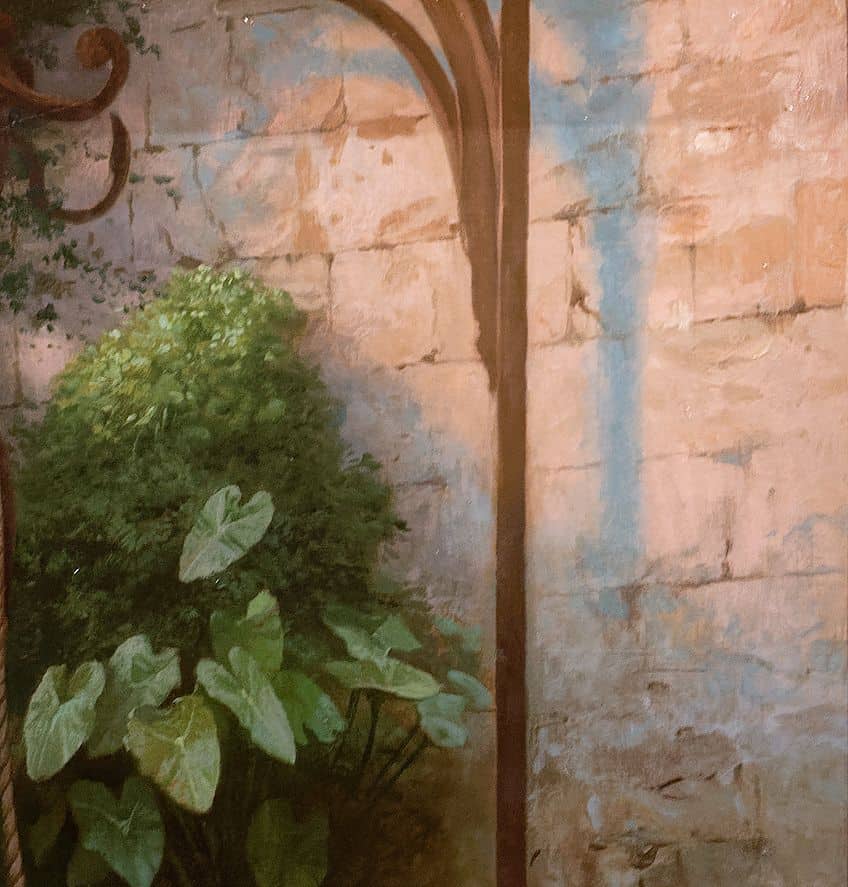
Texture
The texture of the paint in the Truth Coming Out of Her Well painting by Jean-Léon Gérôme appears smoothly applied without any visible brushstrokes. This was characteristic of the artist’s painting style, which was more meticulous in the application and rendering of subject matter compared to the more expressive style of Impressionism, for example.
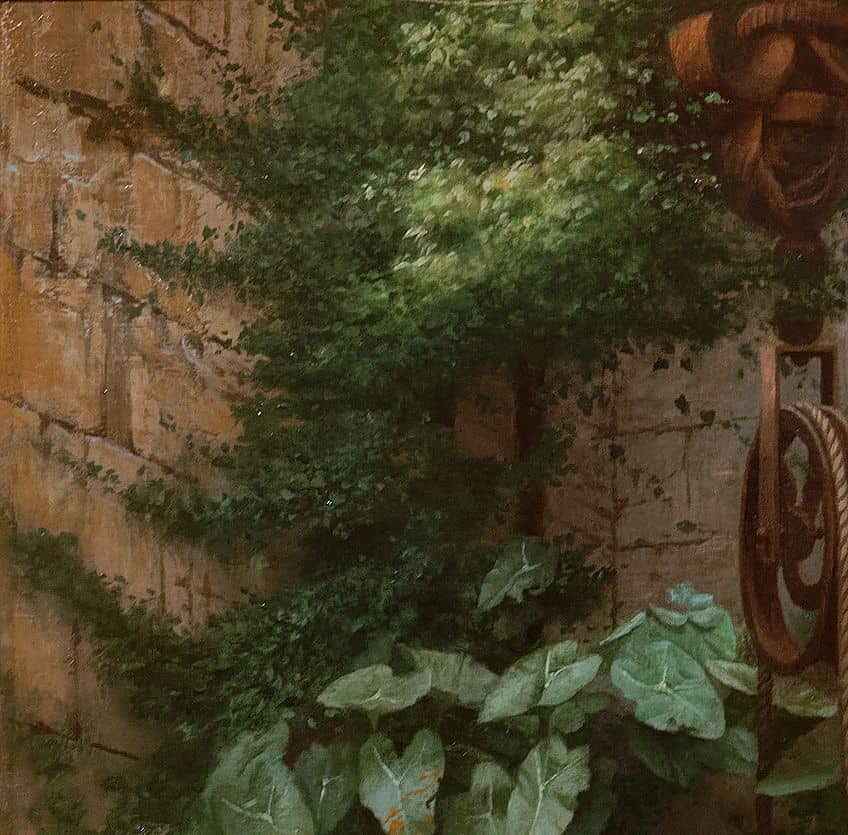
Line
There are various types of lines in Truth Coming Out of Her Well by Jean-Léon Gérôme, notably the implied directional lines created by the placement of objects that lead the gaze to the woman, Truth, who is the focal point. These include the straight vertical lines of the iron rod to the right holding the hanging pulley, the rope hanging into the well, and the shorter line of the woman’s whip in her right hand. Other types of lines include curved and curled lines delineating the various objects, from the foliage to the ornamental curls of the pulley above, including the woman’s curvaceous figure.
Horizontal lines are indicated by the placements of the bricks that make up the wall.
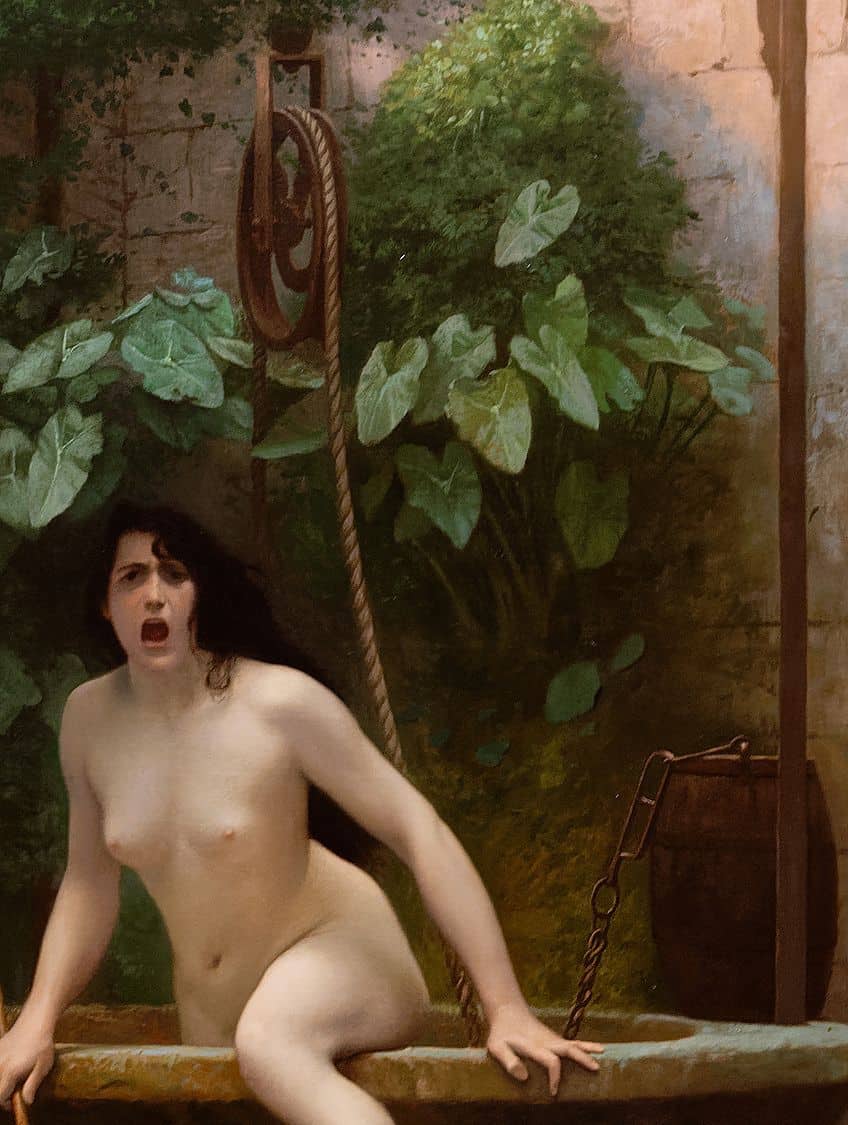
Space
Jean-Léon Gérôme depicted the foreground consisting of the small section of flooring with the woman, Truth, further into the middle ground and background. The latter is filled with the greenery behind the well.
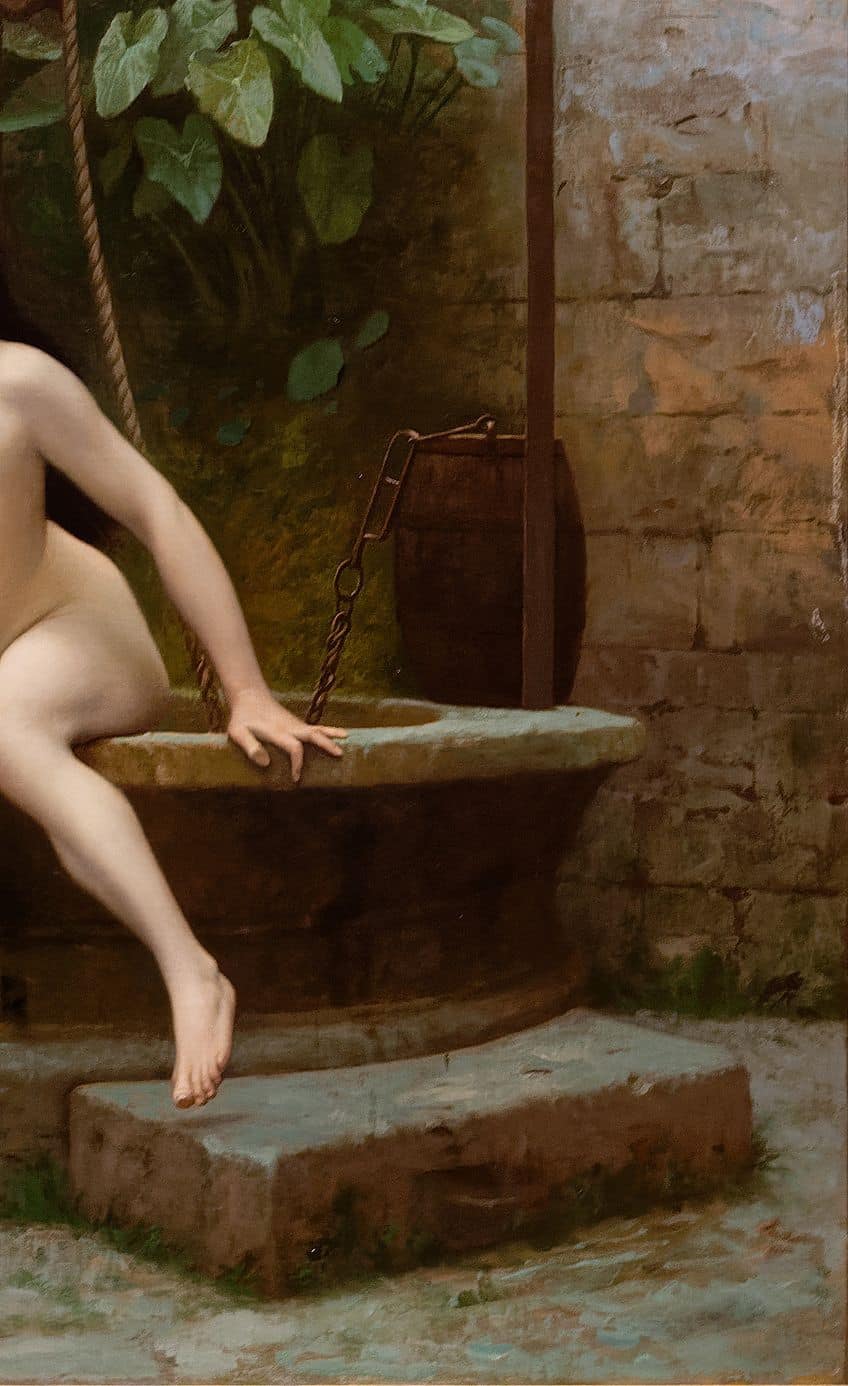
Shape and Form
There are a variety of naturalistic shapes and forms in the Truth Coming Out of Her Well painting. From the naturalistic form of the woman to the foliage behind her, all composed of irregular and asymmetrical shapes and forms that reflect the realism seen in the natural world. There are some geometric shapes evident, especially in the mechanics of the well’s pulley, from circular to square-like shapes.
Additionally, the well itself is a large circular shape, and the bricks of the wall indicate rectangular block-like shapes.
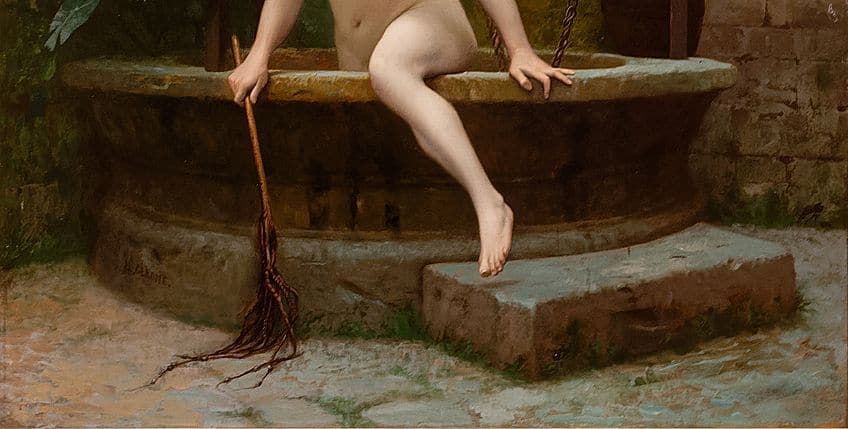
The Truth Is a Mystery
In 1896 Jean-Léon Gérôme exhibited Truth Coming Out of Her Well at the famed Paris Salon and reportedly it has been held and exhibited at the Musée Anne de Beaujeu in Moulins, France from the year 1978. It has also been described by the curators as being their “Mona Lisa” because of the mysterious meanings attached to the subject matter.
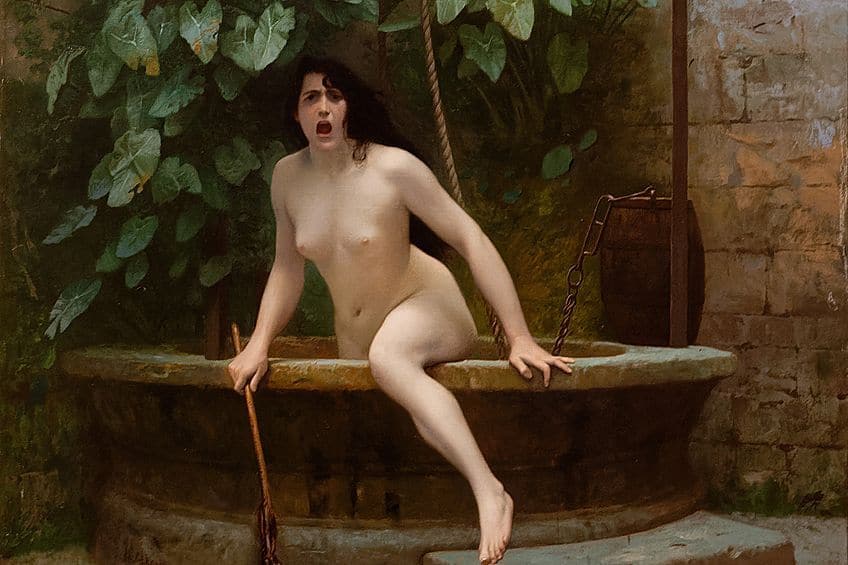
This article explored one of Jean-Léon Gérôme’s last paintings, Truth Coming Out of Her Well, and some of the popular theories around what it means including a description of the subject matter. Reportedly, when Gérôme died in 1904, he had one of his “Truth” paintings with him.
Frequently Asked Questions
Who Painted the Truth Coming Out of Her Well?
The French artist, Jean-Léon Gérôme, painted Truth Coming Out of Her Well (1896). It is also titled Truth Coming Out of Her Well to Shame Mankind. The artist created several paintings (reportedly around four) around the theme of truth, which was depicted as a woman in the nude.
Who Is the Woman in Truth Coming Out of Her Well?
Truth Coming Out of Her Well (1896) by Jean-Léon Gérôme depicts a nude woman who personifies truth. It is believed to originate from the Greek philosopher Democritus.
Where Is the Truth Coming Out of Her Well Painting Located?
Truth Coming Out of Her Well (1896) by Jean-Léon Gérôme is located at the Musée Anne de Beaujeu in Moulins, France. It has reportedly been a part of the museum from 1978. It is uncertain where it was acquired from.
Alicia du Plessis is a multidisciplinary writer. She completed her Bachelor of Arts degree, majoring in Art History and Classical Civilization, as well as two Honors, namely, in Art History and Education and Development, at the University of KwaZulu-Natal, South Africa. For her main Honors project in Art History, she explored perceptions of the San Bushmen’s identity and the concept of the “Other”. She has also looked at the use of photography in art and how it has been used to portray people’s lives.
Alicia’s other areas of interest in Art History include the process of writing about Art History and how to analyze paintings. Some of her favorite art movements include Impressionism and German Expressionism. She is yet to complete her Masters in Art History (she would like to do this abroad in Europe) having given it some time to first develop more professional experience with the interest to one day lecture it too.
Alicia has been working for artincontext.com since 2021 as an author and art history expert. She has specialized in painting analysis and is covering most of our painting analysis.
Learn more about Alicia du Plessis and the Art in Context Team.
Cite this Article
Alicia, du Plessis, ““Truth Coming Out of Her Well” by Jean-Léon Gérôme – Analysis.” Art in Context. May 23, 2023. URL: https://artincontext.org/truth-coming-out-of-her-well-by-jean-leon-gerome/
du Plessis, A. (2023, 23 May). “Truth Coming Out of Her Well” by Jean-Léon Gérôme – Analysis. Art in Context. https://artincontext.org/truth-coming-out-of-her-well-by-jean-leon-gerome/
du Plessis, Alicia. ““Truth Coming Out of Her Well” by Jean-Léon Gérôme – Analysis.” Art in Context, May 23, 2023. https://artincontext.org/truth-coming-out-of-her-well-by-jean-leon-gerome/.



